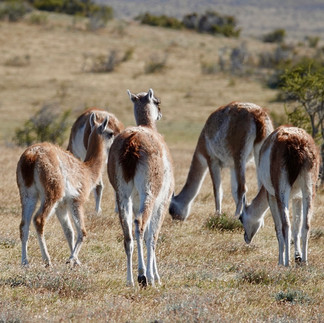Punta Arenas, Chile
- Susanne

- Apr 6
- 6 min read
Updated: Apr 22
Our grand adventure started with 2 months of heavily schuduled activities and our final 4 weeks left us with the freedom to figure things out as we went. That included trying to find a way back to Canada. Up to this point, we had been booking one-way flights as we made our way south. Things were not looking promising in the sense that available flights included multiple layovers over several days and were far more expensive than we had bargained for. It took us a few days to finally find a flight that had only one connection, leaving from Santiago, Chile. So, the decision was made and we were spending our last 2 weeks in 2 very different places; Punta Arenas and Santiago.
Travelling to the end of the world (or almost the end) was surprisingly easy. All it took was an overnight stay at an airport hotel in Santiago and a fairly quick flight down to Punta Arenas. Our room was nice but it was pretty small, especially since we would be staying there for a week. We inquired about a room with a kitchenette and found ourselves repacking and making a quick move to another floor. This hotel did not have an elevator and hauling our luggage up 4 floors and then down 1 had us feeling very strong indeed!

It was early afternoon and we headed out to see what there was to see. As it turns out, Punta Arenas is a very walkable city. It has a beautiful long sea walk beside along the Magellan Strait, and the streets are mostly one-way, making it easy to figure out which way to look before crossing. This was of particular interest to us. Throughout Central and South America, we had learned that pedestrians are not the priority and we gained a healthy respect for traffic. However, we were very surprised when we were crossing the main road in and out of the city. There are designated crosswalks that drivers actually stop at. Not only do they stop, but they stop quickly and put their four-way flashers on to notify other drivers to stop too. What a refreshing change to having to leg it across roads in record times!
Some buildings of interest. Then yellow buiding is a large painted mural.
We spent the rest of our day wandering around in the soft rain and getting the lay of the land. We found a wonderful little cafe with great coffee and purchased some groceries. We also scoped out a restaurant for dinner. Restaurants keep very different hours than those in North America. Many do not open until 7:00pm and they often are closed completely for at least 2 days out of the week. Sotito's turned out to be a very good choice. Fortunately for us, they opened early (6:30). We had fresh fish with vegetables and, of course, wonderful Chilean Carmenére wine.
Terrence had visited Punta Arenas about 18 years ago but things had changed quite a bit. There were several original and new monuments, the city was bigger,and there were more cruise ships stopping. We found this out on our second day as we walked to the main square on our way up to a lookout with a view of the city. Large groups of people were everywhere. I couldn't figure out why at first but then read some of the history behind the monument in the square dedicated to Hernando de Magallanes (Magellan, in English). The bronze statue is the colour you would expect bronze to be, but the right foot of the Indigenous man sitting at the base of the monument was shiny. This is because there is a legend that if you kiss or touch the foot, you will have good luck and calm seas as you pass through the Drake Passage, well-known for its rough waters. The tradition also believes that you will return safely to Punta
Monuments and fantastic views.
Another amazing monument is the Monumento a Tripulantes Galeta Ancud. This statue and fountain is on the waterfront and commemorates Chile's claim over the Strait of Magellan in 1843. The ship is a replica of the schooner, Ancud, and the rocky base symbolizes the rocky Pategonian coast. The men represent 23 expedition members who participated in the dangerous journey leading through the strait.

Tripulantes Galeta Ancud
One day, there was a break in the rain and the temperatures climbed to a balmy 10 degrees Centigrade. It was a great opportunity to go for a hike in the Sendero Los ñirres park. We took a taxi up to the mountain (about 15 minutes from our hotel). As Terrence checked us in and paid the entrance fee, I spoke to one of the guides who showed me the trail routes and described some of the birds and wildlife that might be seen along the way. When I expressed our interest in birding, the guide and his co-worker took us a short distance to show us a Lesser Horned Owl and her owlet. They were both awake and alert and were very curious about us. What a great start to our hike. About an hour in, we reached the first lookout. Another half hour walk uphill took us to our chosen destination, a lookout where we could see all of Punta Arenas and the ocean.
Lesser Horned Owl, Forest Walk, and a White Throated Treerunner
If there is one thing we were disappointed about, it was the inability to find information about almost anything unless we wanted to join an expensive and lengthy tour. Whenever we looked up a potential activity, the search results produced a dozen tours. This was largely unappealing, but we did have to make an exception and purchased 2 spots on the tour to see a King Penguin colony on Tierra del Fuego. This very long day with a lot of driving and 2 ferry crossings was not exactly as advertised, but we were delighted to see the penguins in their natural habitat as well as other amazing wildlife such as guanacos and rheas.
King Penguin colony with a little visitor
The historical economic boom of Patagonia was in large part due to sheep farming. In the late 1800's, sheep stations, or estancias were created for wool production and later, for meat. Unfortunately, sheep required a lot of land and the indigenous populations of the mainland were displaced. On the Tierra del Fuego, the local Selknam people were killed. Their genocide has left a stain on Patagonian history. However, the way of life of the Selknam people has never been forgotten and you can learn all about them at the Museo Maggiorino Borgatello. Large herds of sheep are still seen in the fields but the intense sheep farming practices eventually took second place to oil production in Patagonia.
Ruins from San Gregorio estancia, a group of guanacos, wind-swept tree of Patagonia
It was time for us to get out of the city so we booked a rental car and planned a trip to another part of the Andes with active glaciers, Torres del Paine. We had to leave very early in the morning as it was a 6 hour drive to the gates of the park. Most people who go are there to camp for a few days and/or do long hikes. Since we only had the day, and we had a very long drive back to Punta Arenas, we only stayed for about an hour so we could take some photos and have a laid back picnic lunch.

Torres del Paine from a distance
Throughout this blog, I have mentioned that you have to go with the flow when things do not go as planned. This theory was put to the test the night before flying back to Santiago when we discovered that our flights were leaving from another city. They were booked for Puerto Natales (a city 3.5 hours away) and not Punta Arenas. Panic ensued as we tried to find alternative flights and get refunded for the incorrect one. This was a much more challenging task than expected but we did eventually find a flight with 2 open seats. Terrence had to seek help from our hotel to interpret for him. Everything worked out. The front desk staff worked with the airline and our refund was issued. Whew! Catastrophe averted.
Punta Arenas has much more to offer and to write about it all would best be served by writing a book. The history, geology, and national pride are quietly (but prominantly) shared with visitors. We were there at the end of the traditional tourist season and local people were preparing for a quieter winter without cruise ships and tourists. Although our visit was only for a week, I feel like we learned a lot about this part of the world and look forward to perhaps going back one day.

The End of the World Road




































Comments